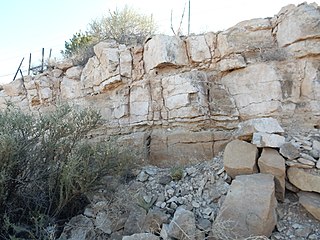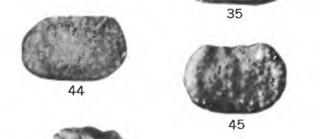
The Cutler Formation or Cutler Group is a rock unit that is exposed across the U.S. states of Arizona, northwest New Mexico, southeast Utah and southwest Colorado. It was laid down in the Early Permian during the Wolfcampian epoch.

The Mancos Shale or Mancos Group is a Late Cretaceous geologic formation of the Western United States.
The Weches Formation is a greensand, slay, and shale geologic formation in Louisiana and Eastern Texas. It preserves fossils dating back to the Paleogene period, specifically the Eocene.
The Bone Spring Formation is a geologic formation found in the Delaware Basin in Texas and New Mexico. It preserves fossils dating back to the Leonardian Age of the Permian Period.

The Capitan Formation is a geologic formation found in western Texas and southeastern New Mexico. It is a fossilized reef dating to the Guadalupian Age of the Permian period.
The Hueco Formation is a geologic formation in west Texas and southern New Mexico. It preserves fossils dating back to the early Permian period.

The San Andres Formation is a geologic formation found in New Mexico and Texas. It contains fossils characteristic of the late Leonardian (Kungurian) Age) of the Permian Period.
The Nocona Formation is a geological formation in Texas, dating back to the Wolfcampian series. As part of the Texas red beds, it is one of several formations renowned for dense bonebeds of terrestrial vertebrate fossils.

The Word Formation is a geologic formation in Texas. It preserves fossils dating back to the Permian period. It is probably named for the Old Word Ranch in the Glass Mountains of Brewster County.

The Park City Formation is a fossiliferous sedimentary formation from the late Permian of Utah, Idaho, Wyoming, and Montana. It is defined by its cherty, gray to pinkish limestone, calcareous siltstone, and cherty sandstone. The rocks in this formation formed along a shallow marine continental shelf and were regularly interrupted by the Phosphoria Formation due to tectonic forces and sea level change.

The Abo Formation is a geologic formation in New Mexico. It contains fossils characteristic of the Cisuralian epoch of the Permian period.

The Campito Formation is a geologic formation in Nevada. It preserves fossils dating back to the Cambrian period.
The Deep Spring Formation is a geologic formation in Nevada. It preserves fossils dating back to the Cambrian period.
The Windfall Formation is a geologic formation in northeastern and southern Nevada.
The Johnson Spring Formation is a geologic formation in California. It preserves fossils dating back to the Ordovician period.

The Puget Group is a geologic group in Washington (state). It preserves fossils dating back to the Paleogene period.
The Mount Hawk Formation is a stratigraphic unit of Late Devonian age. It is present on the western edge of the Western Canada Sedimentary Basin in the Rocky Mountains and foothills of Alberta. It consists primarily of limestone and mudstone, and was named for Hawk Mountain in Jasper National Park by R. de Wit and D.J. McLaren in 1950.
The Castile Formation is a geologic formation in west Texas and southeastern New Mexico, United States. It was deposited in the Ochoan Stage of the Permian period.
The Goat Seep Formation is a geologic formation found in western Texas and southeastern New Mexico. It is a fossilized reef dating to the Guadalupian Age of the Permian period.

Roundyella is an extinct genus of ostracod belonging to the order Leperditellocopida and family Scrobiculidae. Specimens have been found in beds of Devonian to Triassic age in Australia, Asia, Europe, North America, and South America.










